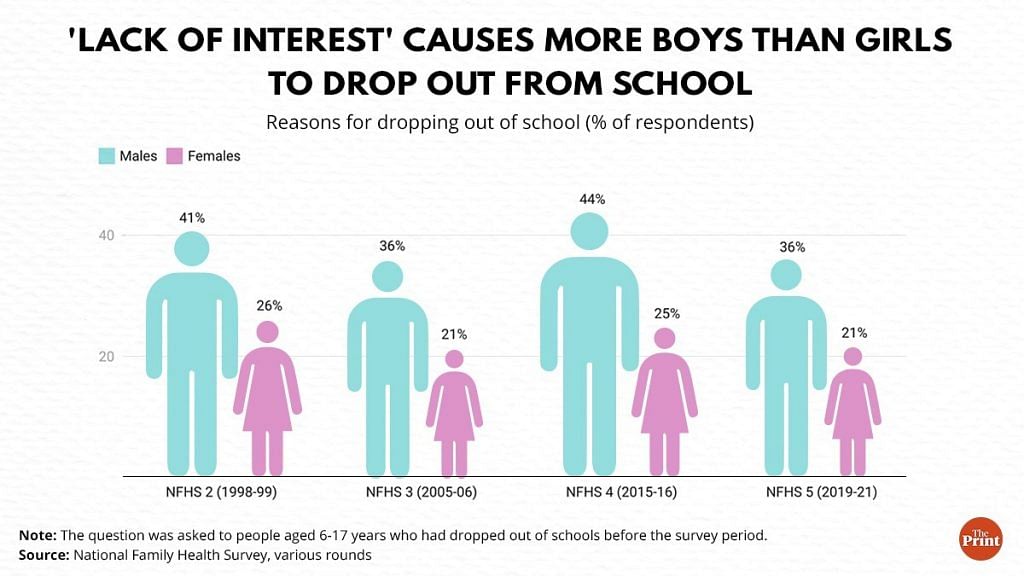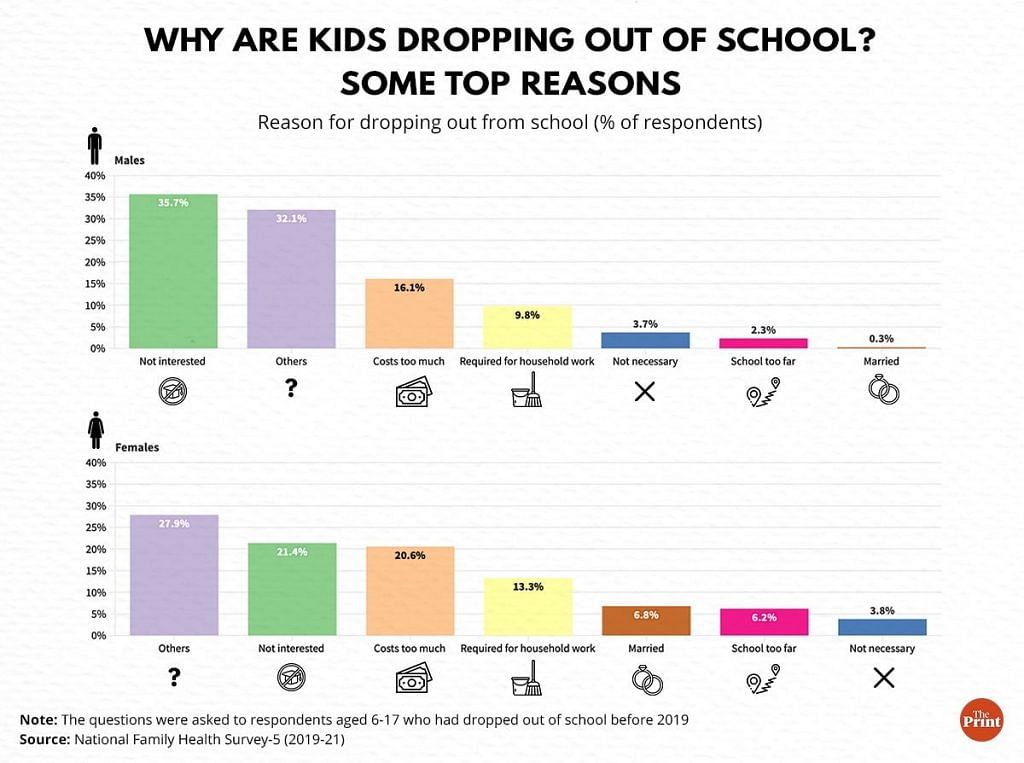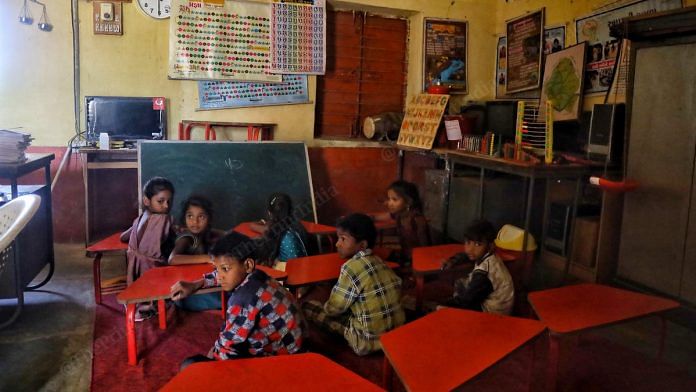New Delhi: From offering financial aid to remedial teaching resources — the Union Ministry of Education is serious about doing whatever it takes to get school dropouts back into classrooms, especially in the wake of the Covid upheaval.
But, the most common reason reported for children dropping out of school is not cost or access, but a lack of interest in studies, according to the findings of the National Family Health Survey (NFHS)-5, conducted in 2019-21. Indeed, this was the main reason found for children abandoning their education in previous rounds of the survey as well.
According to NFHS-5, “not interested in studies” was the reason given by 21.4 per cent of girls and 35.7 per cent of boys aged between six to 17 years for dropping out of school before the 2019-20 school year.
The study, conducted under the aegis of the Union Ministry of Health and Family Welfare by the Mumbai-based International Institute for Population Sciences (IIPS), had surveyed 20,084 boys and 21,851 girls on their reasons for dropping out.
While the NFHS does not mention India’s dropout rate, the Ministry of Education’s statistics present a worrying picture, especially for students in higher classes.
The latest data released by the Unified District Information System for Education (UDISE) in 2020-21 shows that at the primary level, the dropout rate in 2020-21 was only 0.8 per cent, but at the secondary level (Class 9-10), it was 14.6 per cent. Although it is an improvement from 16.1 per cent in 2019-20, it still translates to lakhs of students.
Top reasons for dropping out
It is widely accepted that poverty, distance from school, and parents’ attitudes towards their children’s education are major determinants of whether kids stay in school or not.
The NFHS data, however, shows that the picture is more complex than that. The top reason for dropping out, as mentioned earlier, is “not interested in studies”, with boys (nearly 36 per cent of respondents) much less enthused than girls (about 21 per cent).

The next most frequently cited factor was cost, with about 16 per cent of boys and 20 per cent of girls surveyed attributing dropping out to it.
Next in the list was “required for household work”, due to which about 13 per cent of girls and 10 per cent boys had to abandon their education.
Family’s attitudes towards the child’s education and gender roles also appear to play a role in school dropout rates.
NFHS-5 data shows that about 7 per cent of the surveyed girls had to drop out from school because they got married, while the same reason applied to 0.3 per cent of boys.

Similarly, about 6 per cent of boys (but only 2.5 per cent of girls) left school to “work for payment in cash or kind”, while 4.4 per cent of boys and 2.3 per cent of girls were required to work on for their farm or family business.
“Did not get admission” was cited by about 5 per cent each of boys and girls. Some students also quit school due to “repeated failures” (about 5 per cent for boys and 4 per cent of girls) and roughly 4 per cent of each gender felt further education was “not necessary”.
Distance from school isn’t a big deal-breaker for students as only 2 per cent boys and 6 per cent girls cited it as the reason for dropping out.
Other reasons listed for dropping out for girls included lack of proper facilities (1.7 per cent), no female teacher (0.2 per cent), and safety concerns (2 per cent).
A tiny percentage claimed they didn’t know why they weren’t in school any longer (0.2 per cent each).
Less than 1 per cent of students said they left school to take care of siblings or due to a natural disaster/calamity.
Why no interest?
There could be multiple reasons behind a large percentage of respondents citing a lack of interest in education, according to Dr T.V. Sekher, head of the department of family and generations at the International Institute for Population Sciences.
“Generally, after failing a class or two, the child loses interest in studies. Most of the time, these children are from extremely poor families. If their parents do not value education, it impacts the child’s interest in studies,” he said.
Sekher added that the government’s actions have helped in reducing the dropout rates, but improving interest has not yet been a focus area.
“India’s dropout rate has come down significantly because the government has put in a lot of effort — from providing free and accessible education to providing scholarship and stationery, uniforms etc. But the lack of interest still needs to be addressed,” Sekher said.
“I think at the school level itself, there should be efforts to understand why poor performers are losing interest and what can be done to win their confidence in studies. It could be extra classes or different treatment. Parents should be counselled so that they also value their child’s education. The improvement in interest for studies would require a 360-degree approach,” he added.
A 2019 paper published in the peer-reviewed Journal of Applied Linguistics and Language Research also explored the issues behind children dropping out of school and made note of “lack of interest” as an important factor.
This study, authored by Nagarjuna University’s Syed Rooquiyya Tabassum, recommended that establishing “innovative teaching methods” and “good infrastructure” in schools could help “draw students closer to education” and “spark interest” in them.
(Edited by Asavari Singh)
Also Read: India’s school education now has three class layers. Blame political meddling in syllabus



